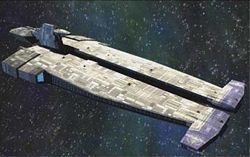Midway-class heavy carrier
| Midway-class | |
|---|---|

| |
| Type | Multi-role Heavy Carrier |
| Manufacturer | TSY Arcology |
| Introduction | 2681 |
| Produced | 2681-2690 |
Class Overview
The Midway-class represents a new direction in carrier design undertaken by the Confederation at the end of the 27th century. Still reeling from the massive financial cost of the Kilrathi War, the Confederation Navy realized that it could not afford to keep fielding large carrier battlegroups. However, the need for force protection and the ability to interdict pirates and Kilrathi raiders still existed. Midway was designed to contain all the necessary aspects of a battlegroup within one hull. More of a mobile starbase then a simple carrier, the class posseses its own research and development, intelligence and supply divisions, combining roles normally filled by specialist ships. One of the key purposes of the Midway design was the ability to operate unsupported in enemy territory, a feature that is shared with the Kilrathi war era Bengal-class. One of the biggest advocates of the class was Commodore Christopher Blair, who helped design the ship with the knowledge gained from his experiences in the war.
Design and Construction
Midway was laid down at the TSY Arcology circa 2676. Her features were designed around an ability to be able to operate behind enemy lines for extended periods without resupply or assistance from other vessels. Her launch and landing bays are decentralized, ensuring that a single torpedo hit can not disable or destroy her ability to launch fighters, a problem that plagued many Confederation carriers during the war. Her hull is split down the middle from the bow to the bridge tower, creating a distinct flat profile with two 'wings'. The separation of these hull components limits the possible spread of damage, allowing one wing to continue operating even if the other has taken hits.
Unlike the preceeding Vesuvius-class, the Midway-class is not designed with heavy energy armament. She is equipped with six Cap-ship missile launchers, allowing a standoff capacity against enemy warships should they enter range. With 25 dual mount laser turrets, six dual mount ion turrets and six IFF missile launchers, the class posseses a formidable anti-fighter armament. Her armor, while still heavy, is significantly thinner than that seen on the Vesuvius-class, allowing more usable space for the ship's science and support facilities. Similarly, her engines are less powerfu The ship mounts six forward facing launch tubes and two landing bays. Midway has the facilities to field a wing of 252 spacecraft, though early ships often sortied with fewer fighters then they were capable of carrying.
The class is also designed to be adaptable to its environment. Many components are removable, allowing much shorter refit times then a conventional fleet carrier. Her facilities were designed with upgrades in mind, so that the ship could be continually updated to meet new threats. One of the best examples of this adaptability was seen when TCS Midway mounted a captured Nephilim ship killing device to its hull for use against an enemy fleet in 2681.
Service History
Midway entered service in 2681 and was deployed to the territories of the former Kilrathi empire to combat piracy and aggressive Kilrathi raiders. When the Nephilim incursion occured in the Kilrah system, Midway was instrumental in defeating the initial Nephilim push, giving the Confederation enough time to mobilize its forces for the coming war. The carrier was able to sustain operations behind the lines for an extended period, showcasing the best traits of Midway's 'all in one' design. Her sister ship Mistral Sea soon entered service as well.
The class grew to a total of ten ships, all of which saw service during the war. They distinguished themselves in conflict, though at a heavy price. Mistral Sea and Jutland were destroyed at some point during the conflict, while Bataan is still listed as missing in action. Also missing is TCS Tripoli, which never returned from her patrol and is assumed to lost. TCS Port Broughton was decommissioned following the conclusion of hostilities. Purchased by private investors, as of 2701 she is now a home for thousands of refugees from the war.
Known Ships
- TCS Midway (CVX-1)
- TCS Mistral Sea (CVX-2) - Destroyed
- TCS Tafanda Bay (CVX-3)
- TCS Coral Sea (CVX-4)
- TCS Jutland (CVX-5) - Destroyed
- TCS Ptoloman's Rift (CVX-6)
- TCS Enyo III (CVX-7)
- TCS Bataan (CVX-8) - Missing
- TCS Tripoli (CVX-9) - Missing
- TCS Port Broughton (CVX-10) - Decommissioned
Specifications (Wing Commander Prophecy)
| Class: | Multi-role Heavy Carrier |
| Length: | 1,800 Meters |
| Mass: | 200,000 Metric Tonnes |
| Max Velocity: | 80 kps |
| Acceleration: | 45 kps/s |
| Max Y/P/R: | 5/5/5 dps |
| Shields: | Phase |
| Fore Armor: | 2,000 cm equivalent |
| Right Armor: | 2,000 cm equivalent |
| Left Armor: | 2,000 cm equivalent |
| Rear Armor: | 2,000 cm equivalent |
| Turret Strength: | 800 cm equivalent |
| Weapons: | Dual Mount Laser Turret (25), Dual Mount Ion Gun Turret (8), IFF Missile Launcher (6), CapMiss Launcher (6) |
| Fighter Complement: | 252 |